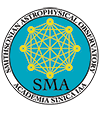 |
|
|
| Research | ||
 Star Formation
Star Formation
We think we know how stars live and die, but our picture of how stars form is incomplete. Astronomers use the SMA to zoom in on star birth, studying the formation and early evolution of both low and high mass stars, their disks, outflows, and magnetic fields.  Dying Stars
Dying Stars
The SMA is able to see the matter stars shed as they die. The dust and gas forms planetary nebulae - some of the most beautiful objects in the sky. This is the process by which much of the material to form rocky planets, like the earth, becomes available for the next generation of solar systems. The solar system is comprised of a variety of bodies, from giant planets like Jupiter to the smallest asteroids and everything in between. RG astronomers use the Submillimeter Array to measure both the thermal emission from solar system objects and spectral lines from their atmospheres.  Our Galaxy's Center
Our Galaxy's Center
The principal focus of the SMA for the study of the Galactic Center region has been to investigate the structure, time variability and polarization of the Sgr A*, the compact radio source associated with the black hole in center of our galaxy. Using the SMA to produce high-resolution images in the far-infrared is an important tool for studying the history of star formation in our universe from detailed studies to better understand neighboring galaxies, to colliding galaxies and extreme starbursts in the early universe.  Watching Solar Systems Form
Watching Solar Systems Form
The solar system is comprised of a variety of bodies, from giant planets like Jupiter to the smallest asteroids and everything in between. RG astronomers use the Submillimeter Array to measure both the thermal emission from solar system objects and spectral lines from their atmospheres.  Polarization Studies
Polarization Studies
Polarized emission of radiation is one of the most important signatures of magnetic fields in the universe. Using a system designed especially for the SMA, scientists are able to learn even more about sources like star forming regions and the center of our own galaxy. | ||
|
|
